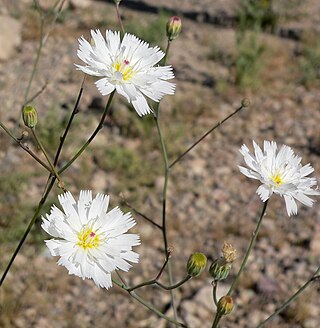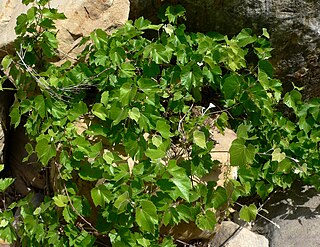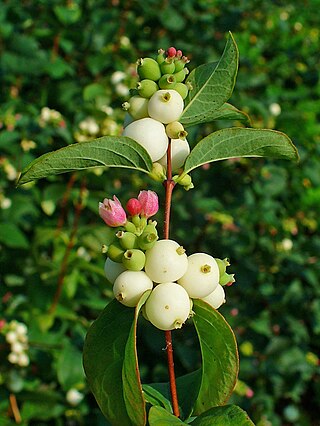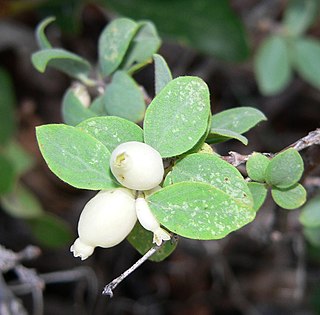
Symphoricarpos, commonly known as the snowberry, waxberry, or ghostberry, is a small genus of about 15 species of deciduous shrubs in the honeysuckle family, Caprifoliaceae. With the exception of the Chinese coralberry, S. sinensis, which is indigenous to western China, all species are native to North and Central America. The name of the genus is derived from the Ancient Greek words συμφορεῖν (sumphoreîn), meaning "to bear together", and καρπός (karpós), meaning "fruit". It refers to the closely packed clusters of berries the species produces.

Chrysothamnus, known as rabbitbrush, rabbitbush, and chamisa, are a genus of shrubs in the family Asteraceae. The native distribution is in the arid western United States, Canada, and northern Mexico. It is known for its bright white or yellow flowers in late summer.

Eriophyllum, commonly known as the woolly sunflower, is a North American genus of plants in the family Asteraceae. The genus is native to western North America, with a concentration of narrow endemics in California.

Symphoricarpos mollis, with the common names creeping snowberry, Southern California snowberry, and trip vine, is a shrub in the Honeysuckle Family (Caprifoliaceae). It is found in western North America from British Columbia to California inland to Nevada and Idaho.

Geraea canescens, commonly known as desert sunflower, hairy desert sunflower, or desert gold, is an annual plant in the family Asteraceae. The genus name comes from the Greek geraios, referring to the white hairs on the fruits.

Atrichoseris is a genus of plants in the family Asteraceae. It contains only one known species, Atrichoseris platyphylla, known by the common names tobacco weed, parachute plant, and gravel ghost.

Baileya multiradiata is a North American species of sun-loving wildflowers native to the deserts of northern Mexico and the Southwestern United States. It has been found in the States of Sonora, Chihuahua, Coahuila, Durango, Aguascalientes, California, Arizona, Nevada, Utah, New Mexico, and Texas.

Fagonia laevis, the California fagonbush, is a species of plant in the Zygophyllaceae, the caltrop family. It is a perennial subshrub of the southwestern United States and Northwestern Mexico desert regions in California, southern Nevada, Arizona, southwest Utah, Sonora, Baja California and Baja California Sur. It thrives upon hot, dry, slopes and hillsides that also receive seasonal-(winters of the Southwest) or monsoon moisture.

Chaetopappa ericoides is a species of flowering plant in the family Asteraceae known by the common names rose heath and heath-leaved chaetopappa. It is native to the southwestern and western Great Plains regions of the United States, plus northern Mexico. It is found in California, Nevada, Arizona, Utah, New Mexico, Colorado, Wyoming, Texas, Oklahoma, Kansas, Nebraska, Chihuahua, Coahuila, Sonora, Durango, Zacatecas, San Luis Potosí, and Nuevo León.

Symphoricarpos occidentalis, commonly called western snowberry, is a woody species of flowering plant in the honeysuckle family.

Vitis arizonica is a North American species of wild grape. It is a deciduous vine.

Symphoricarpos albus is a species of flowering plant in the honeysuckle family known by the common name common snowberry. Native to North America, it is browsed by some animals and planted for ornamental and ecological purposes, but is poisonous to humans.

Symphoricarpos longiflorus is a species of flowering plant in the honeysuckle family known by the common names desert snowberry and fragrant snowberry. It is native to the western United States from the Great Basin to western Texas, as well as northwestern Mexico.

Symphoricarpos oreophilus is a North American species of flowering plant in the Caprifoliaceae, or honeysuckle family, known by the common name mountain snowberry. It has a wide distribution in western Canada, the United States, and northwestern Mexico. It is found in mountainous areas such as the Cascades, the Sierra Nevada, the Rockies, and the Sierra Madre Occidental from British Columbia to the Copper Canyon region of Chihuahua, from the coastal states as far inland as the Black Hills, the Oklahoma Panhandle, and trans-Pecos Texas.
Symphoricarpos palmeri, common name Palmer's snowberry, is a North American species of plants in the Honeysuckle Family. It has been found in the southwestern United States, as well as in the Mexican State of Chihuahua inside Basaseachic Falls National Park.
Symphoricarpos hesperius, called the trailing snowberry or creeping snowberry, is a North American species of trailing shrubs in the honeysuckle family. It is native to southwestern Canada and the northwestern United States
Symphoricarpos acutus, the sharpleaf snowberry, is a North American species of trailing shrubs in the honeysuckle family. It is native to the western United States.
Symphoricarpos microphyllus, the pink snowberry, is a North American species of flowering plant in the honeysuckle family. It is widespread across much of Mexico from Chihuahua to Chiapas, and found also in Guatemala, Honduras, and the US State of New Mexico.
Symphoricarpos vaccinioides is a North American species of flowering plant in the honeysuckle family. It had been found in western Canada and in the western United States.
Symphoricarpos parishii, or Parish's snowberry, is a North American species of flowering plant in the honeysuckle family. It had been found in California, Nevada, Arizona, and Baja California.















